
The Project Gutenberg EBook of The Mentor: The Yosemite Valley, Vol 4, Num. 16, Serial No. 116, October 2, 191, by Dwight L. Elmendorf This eBook is for the use of anyone anywhere in the United States and most other parts of the world at no cost and with almost no restrictions whatsoever. You may copy it, give it away or re-use it under the terms of the Project Gutenberg License included with this eBook or online at www.gutenberg.org. If you are not located in the United States, you'll have to check the laws of the country where you are located before using this ebook. Title: The Mentor: The Yosemite Valley, Vol 4, Num. 16, Serial No. 116, October 2, 1916 Author: Dwight L. Elmendorf Release Date: May 22, 2016 [EBook #52131] Language: English Character set encoding: UTF-8 *** START OF THIS PROJECT GUTENBERG EBOOK THE MENTOR: THE YOSEMITE *** Produced by Juliet Sutherland and the Online Distributed Proofreading Team at http://www.pgdp.net

LEARN ONE THING
EVERY DAY
OCTOBER 2 1916
SERIAL NO. 116
THE
MENTOR
THE YOSEMITE VALLEY
By DWIGHT L. ELMENDORF
Lecturer and Traveler
DEPARTMENT OF
TRAVEL
VOLUME 4
NUMBER 16
FIFTEEN CENTS A COPY
No temple made with hands can compare with the Yosemite. Every rock in its walls seems to glow with life. Some lean back in majestic repose; others, absolutely sheer or nearly so for thousands of feet, advance beyond their companions in thoughtful attitudes, giving welcome to storms and calms alike, seemingly aware, yet heedless, of everything going on about them.
Awful in stern, immovable majesty, how softly these rocks are adorned, and how fine and reassuring the company they keep: their feet among beautiful groves and meadows, their brows in the sky, a thousand flowers leaning confidingly against their feet, bathed in floods of water, floods of light, while the snow and waterfalls, the winds and avalanches and clouds shine and sing and wreathe about them as the years go by, and myriads of small winged creatures—birds, bees, butterflies—give glad animation and help to make all the air into music.
Down through the middle of the Valley flows the crystal Merced, River of Mercy, reflecting lilies and trees and the onlooking rocks; things frail and fleeting and types of endurance meeting here and blending in countless forms, as if into this one mountain mansion Nature had gathered her choicest treasures to draw her lovers into close and confiding communion with her.
JOHN MUIR.

FROM A WATER COLOR PAINTING
CATHEDRAL SPIRES, YOSEMITE NATIONAL PARK
ONE

It was once said that “a man has to be an awful liar to tell the truth about California”; and this applies especially to the wonderful Yosemite (yo-sem´-it-ee) Valley. The name Yosemite means “full grown grizzly bear.” The Valley lies on the west slope of the Sierra Nevada range, and is washed by the Merced River.
There is no record of the early Spanish settlers of California ever having known the Yosemite. It was always a stronghold for the mountain tribes of Indians, and descendants of the Yosemite Indians still live there.
During the gold rush to California, in 1849, a prospector wandering on a trail up the Merced River was the first white man to view this beautiful region. Two years later a band of soldiers came upon the Valley suddenly while pursuing marauding Indians. The discovery came about in this way:
For some time previous to 1851 the Yosemite Indians, believing themselves secure in their mountain stronghold, had given a great deal of trouble to the military authorities of the United States by their defiant plundering. Major Savage, in command of the Mariposa Battalion of United States forces, at first tried to treat peaceably with them. The Yosemites, however, suspicious that Major Savage was merely attempting to get the tribe into his power, would not accept his offers. Then Major Savage went out after them. This was in the winter, and they had to break a trail through the snow. Suddenly they came in sight of a most wonderful valley. They went into camp on the bank of the Merced River, opposite the peak which is now known as El Capitan.
After the meal, in discussing this glorious spot which they had discovered, it was suggested that a name be given it. One of the party, Dr. Bunnell, proposed that it be called the “Yosemite Valley,” to perpetuate the name of the tribe that had so long made its home there. This name was unanimously adopted.
The expedition remained one day and two nights in the Valley, and then were forced to hurry out at the approach of a storm. In three days they had made the round trip through the Valley, exploring it in a general way, and had named some of its principal features. The Indians whom they had gone out to capture, however, were not seen. Later, in 1851, another expedition was made to the Valley in pursuit of the Indians. This was in charge of Capt. John Boling, and Dr. Bunnell accompanied the party. Several Indians were captured, and additional explorations were made.
Not many visits were made to the Valley before 1855. The first regular tourists’ visit was made by J. M. Hutchings, who, having heard of its wonderful scenery, collected a party and went there. The following year regular tourist travel began. The first house built in the Yosemite Valley was erected in 1855. This was afterwards known as Black’s Hotel. It was situated directly opposite the Yosemite Fall. Years ago the old Sentinel Hotel was built by the side of the Merced River, and as patronage increased three cottage annexes to this simple hostelry were erected—one immediately adjoining the hotel building and two across the road. In time a small village grew up along the road and camps were established in the meadows and woods near by. The old Sentinel has now given way to the large new hotel across the river near the foot of the falls. This opens in the beginning of 1917.
The first permanent settler in the Yosemite Valley was J. C. Lamon, who built a cabin in the very end of it in 1860 and planted gardens and orchards. Four years later an act of Congress granted the Valley itself and the adjacent territory to the State of California on the condition that it be held forever as a public park. In 1905, however, California gave back the Valley to the United States, and it now forms part of the Yosemite National Park, which was created in 1890.
PREPARED BY THE EDITORIAL STAFF OF THE MENTOR ASSOCIATION
ILLUSTRATION FOR THE MENTOR, VOL. 4, No. 16, SERIAL No. 116
COPYRIGHT, 1916, BY THE MENTOR ASSOCIATION, INC.

FROM A WATER COLOR PAINTING
YOSEMITE FALLS. YOSEMITE NATIONAL PARK
TWO
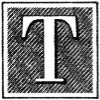
The finest photograph is inadequate to convey to the mind a satisfactory impression of the Yosemite Falls. The Yosemite Creek descends to the valley floor in three leaps, with a total height of about 2,500 feet. It is the highest known cataract in the world. The upper fall has a vertical descent of 1,430 feet; the middle fall consists of a series of cascades, with a total descent of 626 feet; while the lower fall is 320 feet high. At the top the Yosemite Falls is about 35 feet wide. As the season advances and the volume of water decreases, the fall dwindles considerably. At its best, however, it is one of the grandest features of the Valley. In winter a splendid ice cone, 500 feet high, forms at the foot of the upper fall.
Near Cathedral Spires, the Bridal Veil Fall pours down. People love it for its delicate, spirit-like beauty. It has a clear vertical fall of about 630 feet, with a width of 50 to 70 feet. The name is derived from the effect on it of the wind, which makes it flutter like a white veil.
The Bridal Veil shoots from the upper ledge of the cliff by the velocity the stream has acquired in descending a long slope above the head of the fall. Usually the fall strikes on flat topped slabs, which form a kind of ledge about two-thirds of the way down. Between four and five o’clock in the afternoon beautiful rainbows may be seen in this fall.
The Nevada Falls, 594 feet high, is generally ranked next to the Yosemite in interest. It is a heavy, turbulent cataract. Before reaching the bottom of its plunge the fall is broken and scattered by a sloping portion of the cliff about half-way down. It is the stormiest and whitest of all the falls in the Valley.
The Vernal Falls has a vertical descent of 317 feet and varies in width from 70 to 80 feet. This fall is an orderly, graceful, easy-going one. It may be more closely approached than any other. Just above it is the beautiful Emerald Pool.
The Illilouette Falls has a total height of about 370 feet. It is not so impressive as the upper Yosemite, nor so symmetrical as the Vernal, nor so graceful as Bridal Veil, nor so stormy a gush as Nevada; but, as John Muir says, “In the exquisite fineness and richness of texture of its flowing folds, it surpasses them all.”
There are many other small falls and cascades in the Yosemite Valley, among them being the Yosemite Gorge Fall and Cascades, the Royal Arch Falls, the Two Sentinel Cascades, and the falls of Cascade and Tamarack Creeks. The Royal Arch Fall in time of high water is beautiful; and the Two Sentinel Cascades, 3,000 feet high, are also wonderful spectacles. By the middle of summer, however, these have diminished so greatly that they are hardly noticeable.
The volume of water in the falls of the Valley varies greatly at different times—and so do the accounts of the altitude of the cataracts. You may have Illilouette Falls anywhere from 370 to 600 feet high, and the Upper Yosemite Falls anywhere from 1,400 to 1,600 feet high—just according to whom you ask. There is a like variation in the statements of the altitude of summits, and the size and age of the giant trees. Our figures are taken from the documents issued by the Department of the Interior of the United States Government.
PREPARED BY THE EDITORIAL STAFF OF THE MENTOR ASSOCIATION
ILLUSTRATION FOR THE MENTOR, VOL. 4, No. 16, SERIAL No. 116
COPYRIGHT, 1916, BY THE MENTOR ASSOCIATION, INC.

FROM A WATER COLOR PAINTING
EL CAPITAN, YOSEMITE NATIONAL PARK
THREE

First in impressiveness and second only to the waterfalls in beauty, are the summits of the Yosemite Valley. Of all these summits El Capitan stands preëminent, although it is not the highest; that honor belonging to Cloud’s Rest.
El Capitan, probably the largest mass of single rock in the world, stands on the north wall of the valley. It rises almost vertically 3,600 feet above the plain, and it is nearly rectangular in shape. Its two vast faces measure about 160 acres each in area. You can judge of its size by singling out what appears to be a green bush which took root and is growing in a shallow niche far up on the face of the rock. That green bush is called “The Lone Pine,” and it is 150 feet high. El Capitan stands like a grand old veteran, and it is one of the most imposing monuments that nature has left to show the terrific forces which at one time worked their will with this planet. Its summit may be reached by a long and arduous journey, which is seldom undertaken.
Half Dome, or South Dome, as it is sometimes called, rises at the head of the Yosemite Valley to the height of 4,892 feet above the valley floor. It forms the eastern terminus of the Valley. It is one of the wonders of the natural world, and is a unique thing in mountain scenery. Sweeping up 3,000 feet, its walls bear only a few pine trees. Above this it ascends perpendicularly nearly 2,000 feet straight into the sky, while its rounded summit falls steeply curved on the opposite side. It has been described as “incomparably the most wonderful, striking and impressive feature of the region. In strangeness of shape this hemispherical mountain of solid granite is singular among the world’s geological marvels, and its sublime height and firm soaring outline impose it upon the imagination more than would be possible to bulk alone. From every part of the upper half of the Valley the eye is compelled, as if by force of physical attraction, to return to this extraordinary mountain, which one can never tire of contemplating. One looks upon it as one would gaze at some majestic fragment of statuary.”
Half Dome was first ascended in 1875 by George Anderson. He practically pulled himself to the summit by means of a rope attached to iron pegs driven in the rock. He inserted his bolts five or six feet apart, and made his rope fast to each in succession, resting his feet on the last bolt while he drilled a hole for the next above. He accomplished his ascent in a few days; and he hoped to complete a stairway, so that tourists might ascend the Dome. But while he was preparing timber for his stairway he was taken sick, and died all alone in his little cabin.
To the east of El Capitan are the peaks named the Three Brothers, the highest of which, known also as Eagle Peak, is a favorite viewpoint. Glacier Point is another frequently visited peak. It is in many respects the finest point of vantage from which to view the Valley. Opposite is Washington Column, and immediately to the westward of this are the Royal Arches, formed of curious curved layers of rock, firmly recessed, where gigantic displacements have produced a strange vaulted effect. Over these towers North Dome, polished and gray, rises in a perfect curve 3,571 feet above the Valley. It is the best exhibition of the round head rock formation that is so marked a feature of this region.
Guarding the Bridal Veil Falls are the Three Graces. These look across the Valley to their counterparts, the Three Brothers. Near them are Cathedral Rock and Cathedral Spires. Cathedral Rock is not so high nor so massive as El Capitan, nor are its sides quite so nearly vertical. Its summit is 2,660 feet above the Valley. The graceful pinnacles of rock called Cathedral Spires are isolated columns of granite. From one point of view these spires rise above the edge of the cliff exactly like two towers of a Gothic cathedral. They are said to have been given their name because of a fancied resemblance to the Duomo at Florence, in Italy.
Sentinel Rock is the most conspicuous rock on the south face of the Valley. It stands about in the middle of the Valley, and resembles a ruined tower 3,100 feet in height. Beneath Sentinel Rock is Yosemite, the little village of the Valley. Right across the river opposite is the Yosemite Falls.
Cloud’s Rest commands a splendid view of the High Sierra. Cloud’s Rest is a long, bare, steep and extremely high granite ridge. It is higher than Half Dome, being nearly 10,000 feet above sea level.
PREPARED BY THE EDITORIAL STAFF OF THE MENTOR ASSOCIATION
ILLUSTRATION FOR THE MENTOR, VOL. 4, No. 16, SERIAL No. 116
COPYRIGHT, 1916, BY THE MENTOR ASSOCIATION, INC.

FROM A WATER COLOR PAINTING
HALF DOME, YOSEMITE NATIONAL PARK
FOUR

The supreme enjoyment of the Yosemite Valley is to be found by pursuing its trails. There are many of these, some offering more points of interest and beauty than others.
The climb to Glacier Point is of all the most popular. There are three methods of making the ascent—on foot, on horseback, and by auto-car. A great many prefer the horse or mule and the bridle path. This trail leads from the valley floor along the banks of the Merced River and past and above Vernal Falls and on to Nevada Falls. Then it follows the picturesque Illilouette Creek to its fall. Then the trail ascends the steep face of the cliff in zig zags. When the last height is won and Glacier Point is reached, the view is worth all the struggle. From Glacier Point may be seen the Tenaya Canyon, the Vernal and Nevada Falls, the Cap of Liberty, Half Dome, the High Sierra, and most of the Yosemite Valley. There is a comfortable little hotel and a camp at Glacier Point. Many stay over night, and use the spot as a point of departure on various trails—for Sentinel Dome, Taft Point, Dewey Point, and the long trail tramp to Wawona.
The top of Sentinel Dome may be reached from Glacier Point by a short journey, and the trail is in good condition. If possible, the view from here exceeds in grandeur that from Glacier Point.
After reaching Glacier Point most visitors return by the short trail. This zig zags down abruptly, making its descent in four and a half miles. It is full of thrills. For those who are nervous there is just one rule to remember: “Fix your faith on your mule—and hold tight.” The trail passes Agassiz’s Column, a giant obelisk that rises 85 feet in the air from the top of the cliff, leads by Sentinel Falls, and emerges on the plain below at the foot of Sentinel Rock.
The ledge trail is the most difficult. It goes almost straight up from Camp Curry at the base of Glacier Point. This ascent has been made in a little over an hour. It is a trail that only strong climbers should attempt.
Another wonderful climb is that to Eagle Peak and Yosemite Point. A steep but well-made bridle path crosses the bridge over the creek descending from Yosemite Falls. The trail goes to the right shortly after, and, ascending some distance, finally reaches a spot near the foot of the Upper Yosemite Fall. Then the trail leads to the top of the Yosemite Fall and from there a path goes to Lake Tenaya. The view from Eagle Peak extends further to the west than that of Glacier Point.
The trail to Vernal and Nevada Falls leads past Happy Isles and is full of beauty and interest. It winds along the side of the rushing Merced River. The trail leads over a bridge commanding one of the best views of Vernal Falls, and shortly after passing Register Rock, it leads to Vernal Falls. Behind this fall rises the picturesque Cap of Liberty. This may be ascended by experts, but it is a difficult climb. The top of Vernal Falls may be reached by an easy path protected by an iron chain.
From Register Rock the trail, which now becomes narrower and steeper, makes a wide sweep to the right before reaching the top of Vernal Falls, where the flat rock permits an approach to the edge of the water. Just above is the beautiful Emerald Pool. The trail recrosses the river about half-way between the top of Vernal Falls and the bottom of Nevada Falls. Above the bridge is the Diamond Cascade, and below it is the Silver Apron, both beautiful waterfalls. From here may be obtained a fine view of the superb Nevada Falls. A steep and zig-zag trail leads to its top.
To reach Cloud’s Rest visitors follow the Vernal Falls Trail, diverging from it before reaching the bridge above the falls. The trip to Cloud’s Rest takes one day, and is a favorite among energetic tourists. From the Cloud’s Rest trail climbers can turn east and ascend the round summit of Half Dome. The extraordinary formation of this mountain attracts climbers, who are curious to see what the top of it is like. They find it to be just what they expect—a curved, smooth surface.
For anyone who has two or three days to spare for a single expedition, the trip to Merced Lake is a choice one. The lake is reached in one day by the trail that leads to Vernal and Nevada Falls. After the falls have been left behind the trail is a rough, wild path, disclosing scenes of great beauty on every hand. There is a comfortable lodge at the Lake, and in its waters are more fish than you can catch—yes, you and all your friends—in many a day.
Some of these trails lead on into the larger spaces of Yosemite National Park. The great majority of visitors confine themselves to the territory included in the Valley.
PREPARED BY THE EDITORIAL STAFF OF THE MENTOR ASSOCIATION
ILLUSTRATION FOR THE MENTOR, VOL. 4, No. 16, SERIAL No. 116
COPYRIGHT, 1916, BY THE MENTOR ASSOCIATION, INC.

FROM A WATER COLOR PAINTING
THE THREE BROTHERS, YOSEMITE NATIONAL PARK
FIVE

The Valley is a camper’s paradise. Years ago travelers discovered its many advantages. The combination of deep shaded woods and open meadows, with a fine water supply close at hand, made its appeal to all lovers of nature, and long ago the Valley became a favorite resort for campers. Out of single parties, there soon developed an organized camping system in the Valley. As a result, there are now a number of little tent and bungalow communities, with populations varying from two or three hundred up to nearly two thousand. At one time, during 1915, the population of Camp Curry exceeded two thousand. To the lover of out-door life who wants to rest close to the earth, there is nothing more delightful than tent and bungalow life. The United States Government and the Park Service Company offer every convenience to campers, so that no one need bring material nor any supplies into the Valley. The camper may determine the conditions under which he will live. He may bring his own tent, if he cares to. Then, after securing a permit, he may pick out his own spot and raise his simple roof tree. Aside from the established camps there are spaces of land set apart and numbered, and these are for the use of those utterly care-free pilgrims who prefer to settle on a spot of their own choosing and lead the simple life. Upon arriving, the prospective camper can get a full equipment on reasonable terms. A list will be supplied to him, from which he can select every necessary thing for camp life—from a can-opener and tin pan to tents and tables. He can purchase these articles, or he can rent them by the week. If a vagrant life is desired, the camper may secure a pack-mule, pull up stakes from time to time, and move about as he chooses.
This is camp life in its most elementary aspect. From that the conditions of tent and bungalow life in the Valley range up to the finely equipped and organized camps, where the visitor may enjoy all the advantages and luxuries of comfortable hotel life, while at the same time living close to the ground. The established camps at present are Awahnee, El Capitan, Yosemite Camp, Lost Arrow and Camp Curry. The affairs of each camp are managed from its own central office, a building where mail is received and the interests of the campers are looked after. The daily life of these communities is full of incident. Each camp has its entertainments and its gala performances. One has a fine, large bathing pavilion and plunge; another, a festival hall. Moving pictures are exhibited in the evenings; there are lectures and concerts; and a large, well equipped dancing pavilion makes the hours fly fast for young people. Communication between the camps is easy, for there are auto-buses, “jitneys,” as well as ponies and burros, and things are stirring actively among the camps most of the time. No one need lack for entertainment. Between the single tent in a remote part of the Valley and the populous camp community there is a wide range for choice, and variety of conditions enough to make everyone happy.
PREPARED BY THE EDITORIAL STAFF OF THE MENTOR ASSOCIATION
ILLUSTRATION FOR THE MENTOR, VOL. 4, No. 16, SERIAL No. 116
COPYRIGHT, 1916, BY THE MENTOR ASSOCIATION, INC.

FROM A WATER COLOR PAINTING
VIEW FROM GLACIER POINT TRAIL, YOSEMITE NATIONAL PARK
SIX
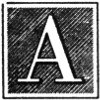
A most interesting feature of the Yosemite region is the Big Trees. There are three groves of giant trees near the valley—the Tuolumne, Merced, and Mariposa. The first two named are small groves. The important grove is the Mariposa. This grove is so called from its situation in Mariposa (Butterfly) County. It occupies a tract of land about four square miles in area, and consists of two definite groups of trees. Its elevation above the sea level varies from 5,000 to 8,000 feet.
The Big Tree, or Sequoia gigantea, is found only on the west slope of the Sierra Range. The Redwood, or Sequoia sempervirens, its twin brother, is strictly a seaboard tree, being confined to the coast ranges. The Big Tree, however, is the giant of all, and it is of this species that the Mariposa Grove is made up.
The first grove of Big Trees discovered by white men was the Calaveras Grove of Big Trees in California. This was in the spring of 1852, and the discoverer was A. T. Dowd. Soon the story of the Big Trees found its way into the newspapers, and no other plant ever attracted so much attention or gained such celebrity within so short a period. The species was named in honor of Sequoyah, or Sequoia, to give it the Latin spelling, a Cherokee Indian of mixed blood, who was also known as George Guess. He invented an alphabet and written language for his tribe.
The Big Trees are the oldest living things in the world. It is impossible to appreciate their huge size from a mere description. They must be seen; and even then a sense of futility strikes the beholder. The Big Trees grow in groves, never forming groups by themselves, but always scattered among a much larger number of trees of other kinds.
Says John Muir, the famous naturalist: “The whole tree for the first century or two, or until it is a hundred or one hundred and fifty feet high, is arrowhead in form, and, compared with the solemn rigidity of age, seems as sensitive to the wind as a squirrel’s tail. As it grows older, the lower branches are gradually dropped and the upper ones thinned out, until comparatively few are left. The immensely strong, stately shafts are free of limbs for one hundred and fifty feet or so. The large limbs reach out with equal boldness in every direction, showing no weather side, and no other tree has foliage so densely massed, so finely molded in outline, and so perfectly subordinate to an ideal type. A particularly knotty, angular, ungovernable-looking branch, from five to seven or eight feet in diameter, and perhaps a thousand years old, may occasionally be seen pushing out from the trunk as if determined to break across the bounds of the regular curve, but like all the others it dissolves in bosses of branchlets and sprays as soon as the general outline is approached. Except in picturesque old age, after being struck by lightning or broken by thousands of snow-storms, the regularity of forms is one of their most distinguishing characteristics. Another is the simple beauty of the trunk, and its great thickness as compared with its height and the width of the branches, which makes them look more like finely modeled and sculptured architectural columns than the stems of trees, while the great limbs look like rafters, supporting the magnificent dome-head. But though so consummately beautiful, the Big Tree always seems unfamiliar, with peculiar physiognomy, awfully solemn and earnest; yet with all its strangeness it impresses us as being more at home than any of its neighbors, holding the best right to the ground as the oldest, strongest inhabitant.”
The Mariposa Grove—which was discovered in 1857 by Galen Clark—lies in a little valley occupying a depression on the back of a ridge. The Lower Grove contains 240 fine Big Trees. The Grizzly Giant is the largest of all. It has a circumference of ninety-three feet and a diameter of thirty and six-tenths feet. Its main limb is six and one-half feet in diameter. This tree is very much injured, and its size has been decreased by burning. It has long since passed its prime, and has a battered and worn appearance.
In ascending to the Upper Grove the road goes through a tunnel cut through the heart of the “Wawona,” a living Sequoia. This tunnel is ten feet high and nine and one-half feet wide at the bottom.
The Upper Grove contains 360 Big Trees, averaging in age about 2,500 years. About ten of the trees exceed 250 feet in height. Three of these have a circumference of over ninety feet.
The bark of the largest trees is from one to two feet thick. Toward the end of winter the trees bloom, while the snow is still eight or ten feet deep. The flowers are pale green and pale yellow. The seeds are small and light. The cones remain on the tree for many years.
The Big Trees might live forever. There is no absolute limit to their existence. Death is due only to an accident. The leaves alone die of old age, and these are renewed.
PREPARED BY THE EDITORIAL STAFF OF THE MENTOR ASSOCIATION
ILLUSTRATION FOR THE MENTOR, VOL. 4, No. 16, SERIAL No. 116
COPYRIGHT, 1916, BY THE MENTOR ASSOCIATION, INC.
THE MENTOR · DEPARTMENT OF TRAVEL · OCT. 2, 1916
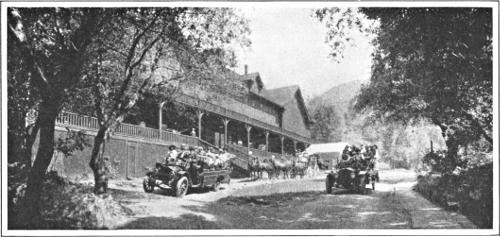
Photograph by J. T. Boysen
EL PORTAL
The terminal of the railroad. From here a run of 10 miles is made up Merced Canyon to Yosemite Valley
By DWIGHT L. ELMENDORF
Lecturer and Traveler
MENTOR COLOR PLATES
Entered as second-class matter March 10, 1913, at the postoffice at New York, N. Y., under the act of March 3, 1879. Copyright, 1916, by The Mentor Association, Inc.

Rest here for a time by the side of the Merced River while I tell you something of this peaceful, lovely valley. Look over to that further cliff and watch the silver stream of the Yosemite descend in three gleaming white steps from the summit of rock 2,600 feet above us to the meadow level where we stand. In its first flight of 1,430 feet it falls a third of that distance in a snowy column, then turns to wreathing smoke, through which many glistening darts shoot down to the rocky basin below. Here the misty elements are resolved again into water, and the stream tumbles frothing through rocks to its second flight, then on to the lower fall of 320 feet, when it dashes on a bed of boulders and hurries to join the Merced River.

Photograph by A. C. Pillsbury
THE GATE TO THE VALLEY
Bridal Veil Falls at right of picture
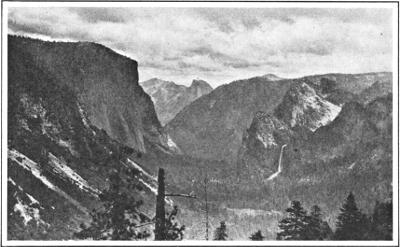
Photograph by A. C. Pillsbury
VIEW FROM INSPIRATION POINT
Bridal Veil Falls in the distance at right of picture
It is an ever present sight in the heart of the Valley, and our eyes turn to it frequently during the hours of daylight. And, all through the night, we hear the hushing sound of its falling waters as it whispers to us of the many beautiful things that Nature has given us in this valley of enchantment.
So you see Yosemite in midsummer. Then its fall is almost as fairy-like as that of Bridal Veil. But in April and May, when it pours down the accumulation of the winter snows, it is a foaming torrent, and its tone is deep and strong.
The Yosemite has been gradually disclosing its features to us since early morning. The first impression that we experience as we leave the town of Merced is one of steady ascent into a narrow gorge, through which a busy, turbulent stream—the Merced River—pursues its course. The train labors sturdily up until it reaches El Portal, where there is a pause at the hotel for lunch. Then the trip is resumed in auto buses that take us on up through a valley, winding and narrowing into a notch that seems at times as if it would end in sheer walls of rock. But, in the course of an hour or more the way broadens, and we find wider stretches, wooded with tall pines and stately sequoias.
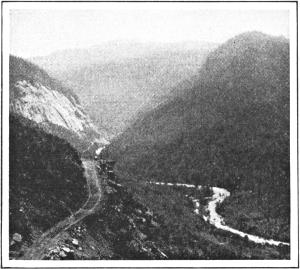
Photograph by A. C. Pillsbury
MERCED CANYON
The approach to the Valley
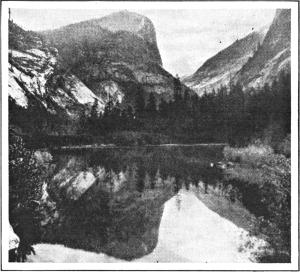
Photograph by A. C. Pillsbury
MIRROR LAKE
As seen in the early morning
Then we catch a glimpse of Elephant Rock, of Cathedral Spires, of the delicate lacery of Bridal Veil Falls, and, opposite, the massive bulk of El Capitan. Soon the slender, swanlike neck of Yosemite Falls appears, and we roll through Camp Awahnee and out into the wide, level vale where Yosemite Village rests. Here we draw a long breath, and a sense of peace and contentment takes possession of us—a feeling of complete isolation from the world of care and trouble. There is something so intimate and friendly—so “homey”—about the wide, green meadow that stretches before us from the banks of the fast flowing Merced to the wood at the foot of Yosemite Falls. Around this level mead the camps cluster; Yosemite, El Capitan, and Lost Arrow camps close to the base of the falls, quiet Camp Awahnee by the roadside across the river, and busy Camp Curry a mile east of the village and just below Glacier Point.
We are now in the very center of Yosemite Valley—though not of Yosemite National Park. Do not mistake the part for the whole. The Yosemite National Park—created a park October 1, 1890—is a huge tract of land, 1,124 square miles in area. It contains many valleys, mountains, streams, lakes, and waterfalls. Its vast territory has been explored by countless travelers, and it is the favorite playground of the Sierra Club—a body of hardy and adventurous men and women trampers, campers, and mountain climbers.
The particular gem of the Yosemite National Park is our dearly treasured Yosemite Valley, seven miles in length—and that is what we have come to visit. When we arrive there we reach a high elevation. The floor of the Valley is 4,000 feet above sea level, and on all sides the mountains rise to heights varying from 3,000 to 6,000 feet more. The highest point in the Valley is the summit of Cloud’s Rest, which is nearly 10,000 feet above sea level.
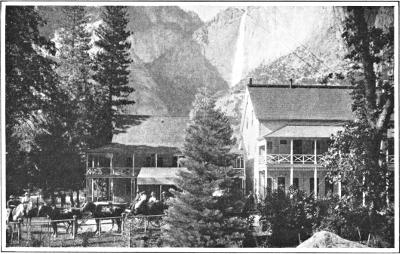
Photograph by J. T. Boysen
FORMER DAYS
Four-horse stage in front of the old Sentinel Hotel. Yosemite Falls in the background
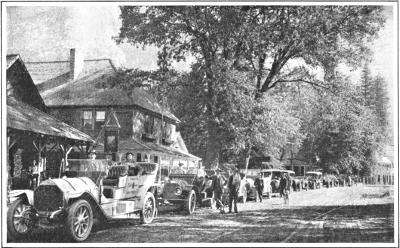
Photograph by J. T. Boysen
THE PRESENT DAY
Automobiles everywhere. There is even a “jitney” service in the Valley
And, now that we are here, you ask: “What is this valley, and how did it come to be?” There are several geological explanations of it, varying in character. Prof. J. D. Whitney, the first scientist to study the Sierra, thought that the Yosemite was “the result of the sinking of a local block of the earth’s crust having the exact outlines of the Valley,” and he denied that glacial action had anything to do with it. But the generally accepted explanation is that the Valley was once a tortuous river canyon cut by the Merced River, and that the cutting work of this stream was done so fast that the “tributary valleys soon remained hanging high on either side.” Then the canyon became the bed of great glaciers which, in moving, “scooped” the Valley into its present form. This, of course, was a matter of hundreds of thousands of years.
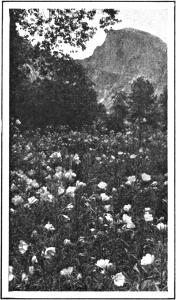
Photograph by A. C. Pillsbury
EVENING PRIMROSES
Half Dome at the back
Accepting that explanation as correct, many of the natural conditions that we find in the Valley are easy to understand—such as the smooth polished surfaces of El Capitan and Half Dome.
And now you ask: “What is there to do and see?” It is a valley of varied diversions. There are many things to do and many beautiful spots to visit, and you may choose according to your tastes and your physical ability. Are you a sturdy tramper? You may take your pack and staff and assail the mountain citadels that challenge you on every side. Do you love the saddle? You can find bridle paths that will lead you through the cool, dense woods, by lakesides, to the foot of waterfalls, and up to the summits. Are you unequal to the exertion of tramping or riding? The joys of the Yosemite are yours none the less, for high powered auto cars will carry you in comfort to the points of greatest interest in the Valley, out to the groves of giant trees, and even up to the supreme commanding spot of all—Glacier Point.

Photograph by A. C. Pillsbury
WINTER SCENE
Half Dome in white
You may take in the Yosemite as a visiting tourist, in which five or six days may suffice you for sightseeing, or you may settle down as a camper or hotel guest, in which case days and weeks slip by, and you soon lose all sense of time in the sweet repose of the Valley. For the greater number a touring visit is all that is possible. You tell me that you are here for a few days. How may you best occupy them? It is not necessary for me to answer your question in detail, for the affairs of the Valley have been systematized in a most businesslike fashion, and all such information is ready to hand. You can obtain schedules of trips for two, three, four, and on up to nine and ten days. The United States Government has done and is doing a good work in developing this great natural recreation park, and all the Government asks of us is that we will take advantage of it. The attitude of Uncle Sam is expressed in the legends posted on trees throughout the Valley, all of which mean in substance: “This beautiful park is yours. Help us to preserve it and make it attractive.”
We have come up from Merced in the morning, and we have arrived in the Valley at three o’clock. Let us make the most of the remainder of this fair summer afternoon. We walk out across the green meadow for a closer view of Yosemite Falls. The shadows of El Capitan and the Three Brothers are already creeping over the valley, and the air has a touch of evening cool as we enter the woods. The walk is longer than we thought. The tall, sheer cliffs make the falls seem nearer than they are. At length, after pursuing the path for some distance through the woods, we come upon an open spot from which we can gaze up and drink in the beauty of the three white leaps of water. This is the favorite spot—the choice viewpoint of artists and photographers. A short climb brings us to the foot of the lower falls, and there we rest and watch the seething basin while the soft mist plays upon our faces. The woods about us are in deep shadow and odorous of pine. Above us goes the trail that leads up through a narrow gorge to a point at the summit of the falls. We are seated in the very sanctuary of the Yosemite. It is an hour to remember.

Photograph by A. C. Pillsbury
THE ZIG ZAG
On the Glacier Point Trail
On returning, we pause a moment by the roadside on the meadow at the concrete bench placed there in memory of Galen Clark, a lover and student of the Yosemite, and discoverer of the giant trees of the Mariposa Grove. Galen Clark apparently drew vitality from his aged tree friends, for he lived to be 96 years old. He is buried in the Valley, and the concrete bench is placed on the spot where he frequently sat to gaze on the falls. Though it is now evening and the sun has disappeared, the Valley is suffused with soft reflected light from the huge flat, mirror-like face of Half Dome. In the course of an hour the golden glow on that great oval surface of rock far above us turns to shimmering silver, and then to a ghostly gray that finally gives way to night.
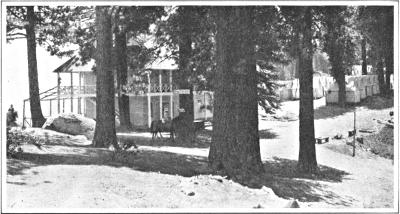
Photograph by A. C. Pillsbury
GLACIER POINT HOTEL AND CAMP
3,254 feet above the Valley and 7,250 feet above sea level
In the early morning let us go to Mirror Lake. This beautiful little sheet of water lies not far from the village and in a natural bowl at the foot of Half Dome and Mount Watkins. The mirror effects are best seen in the early hours shortly after sunrise.

Photograph by J. T. Boysen
A FOREST FRIEND
He prefers sweets, but he will accept eagerly any form of nourishment—and he does not scorn tobacco
On the way back stop for a half hour at Happy Isles. That brief visit will not suffice you, for you will find time, even in a short stay in the Yosemite, to slip away for several half hours to the quiet shades and laughing waters of Happy Isles. The Merced has woven a necklace of sparkling waves about these little wooded islands, and made of them an ideal retreat for a sunny afternoon. If you rest there late in the day look for the dainty little water bird that John Muir calls the “water-ouzel.” I watched one for an hour on the lower island. He has his nest close to the surface of the stream, and he plays joyously, half in and half out of the water, part time flitting over the spray, and part time dipping under, until his sleek gray-black coat shines like satin.
There are trails and roads in all directions. What will you choose? Since you have now seen Happy Isles, go on to the foot of Vernal Falls. You have simply to follow the path past Happy Isles, and go on up the Merced River. It will repay you, for Vernal Falls is a beautiful down-pour of water, 317 feet in height. And, while you are following this trail, go on still further till you reach Nevada Falls, the most impressive of all the cataracts in the Park. Its height is 594 feet, and the volume of water that it pours exceeds that of any of the others. If you would get an adequate impression of its power, climb to the top of Nevada Falls and look down. You will not forget the sight.
If you love fishing, you would do well to take your rod on such a trip, for trout can be found in the pools of the Merced. If fishing is your main object, follow the trail on up to Merced Lake, where you may be assured of finding a full day’s sport.
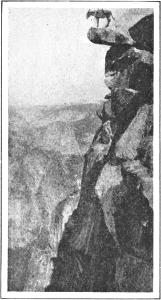
Photograph by A. C. Pillsbury
“WINKEY” AT GLACIER POINT
If, however, tramping and climbing are your choice, you can continue from Nevada Falls and go on one or the other of two splendidly adventurous trails—either turning up to the left to climb the summit of Cloud’s Rest or Half Dome, or winding to the right to reach far-famed Glacier Point. If you take the latter trail you will catch a fine view of Illilouette Falls, a beautiful cataract 370 feet in height, seen only by hardy climbers.

Photograph by A. C. Pillsbury
CAMP CURRY
You may not be equal to such a climb. If so, save Glacier Point for a special trip—on muleback if you can stand it; if not, then go up the road in an auto car. There are a number of ways of scaling Glacier Point. I have mentioned one trail. The bridle trail goes up the long way and comes down the short—all done in one day if one chooses. This trail offers many scenic beauties and some real thrills for those unaccustomed to dizzy heights. The shortest way of all is what is called the “ledge trail,” which starts near Camp Curry, directly underneath Glacier Point, and goes pretty nearly straight up. This calls for the sturdiest kind of climbing—and some nerve.
“All very well,” exclaims the timorous, “but for me, the auto car.” And, indeed, the auto car trip offers many advantages besides comfort and ease. The road for part of the way is the one that you take to Wawona and the big trees. You pass Artists’ Point and Inspiration Point, both of them affording lovely views. Then you turn off and pursue a course along the mountain ridge for miles. There, 7,000 feet in altitude, you wind through magnificent woods of pine and sequoia that line out majestic cathedral naves before you. The somber shadows that envelop you are shot through with golden beams of light. Occasionally you come upon rich green, natural open meadows, where wild flowers abound. A black or brown bear may cross your path. He is a well-behaved citizen, and he will accept appreciatively any nourishment that you offer him.

Photograph by A. C. Pillsbury
WINTER AT GLACIER POINT
You may go to Glacier Point and back by auto car in one day, but I advise staying over night. By all means see the sunset and sunrise from Glacier Point—and then you will feel that you really know the Valley. It lies there like a map below you. Opposite you rise the great heights of El Capitan, Three Brothers, Yosemite Point, North Dome, Basket Dome, and Watkins. The Tenaya Canyon stretches off to the northeast. To your right rise the peak of Cloud’s Rest and the bald head of Half Dome, and below them, still further to the right, is the Little Yosemite Valley, down which pour the torrents of Nevada and Vernal Falls. Both cataracts are in sight from where you stand, and you can plainly hear the sound of their waters. And beyond all these, and stretching far away to the horizon, are the snow-capped summits of the High Sierra. Beneath you, 3,200 feet down, lies the floor of the Valley. And, as the shadows of night gather, the lights of the village and the camps twinkle there like reflected stars.
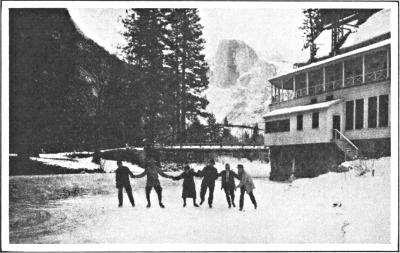
Photograph by A. C. Pillsbury
SKATING ON THE MERCED
There are three groves of giant sequoias in the Yosemite region—the Tuolomne, the Merced, and the Mariposa—and they are visited by almost everyone who goes to the Yosemite Valley. The Tuolomne and Merced groves may be seen in a single day’s trip, for they are not far apart and neither of them is large. The Merced Grove contains forty giants, the Tuolomne twenty, the chief of which is the Dead Giant. Cars drive through this monster just as they do through the Wawona tree in the Mariposa Grove. The ride to the Tuolomne Grove is very picturesque and thrilling, offering one special point of advantage—New Inspiration Point, from which, in the afternoon, Bridal Veil Falls may be seen playing through constantly shifting rainbows.
Mariposa Grove was discovered in 1857, and is the largest grove of its kind in the world. It contains more than five hundred monster sequoias, the largest of which is the famous Grizzly Giant, 204 feet in height and about 30 feet in diameter at the base. You may be told that this is the largest tree in the world. That is not true. There are several larger sequoias. The General Grant tree in General Grant Park is 264 feet in height and nearly 35 feet in diameter. The largest known tree is the General Sherman in the Sequoia National Park, which measures 280 feet high and is 36 feet and 5 inches in diameter at the base.
You may be told also that these great trees are seven and even eight thousand years old. Take that statement with consideration. The sequoias are very hardy vegetables, and are undoubtedly the oldest things living, but the scientists tell us that the veteran trees run in age from 1,500 to 2,500 years, and that the oldest tree, of whose age record there is no question, is somewhat over 3,000 years old. John Muir states that he has found one tree for which he claims an age of 4,000 years.
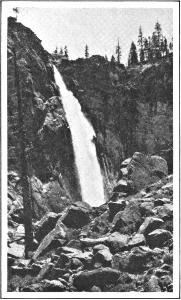
Photograph by A. C. Pillsbury
ILLILOUETTE FALLS
370 feet in height
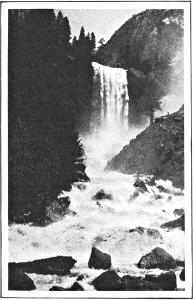
Photograph by A. C. Pillsbury
VERNAL FALLS
317 feet in height
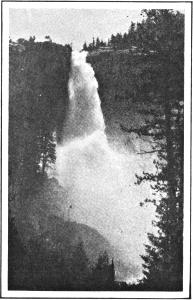
Photograph by A. C. Pillsbury
NEVADA FALLS
594 feet in height
But a matter of a thousand years or so does not detract from the dignity of these majestic forest Sons of Anak. Their age and size are enough to command our reverence, and no one should visit the Yosemite without going to the groves to pay respect to these ancient monarchs.
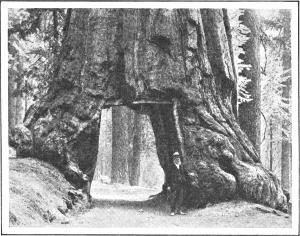
Photograph by J. T. Boysen
THE WAWONA TREE, MARIPOSA GROVE
In front of the tree stands Galen Clark, who discovered the Mariposa Grove of Big Trees in 1857
You must visit the Mariposa Grove at least, and I urge you to give it a special day. You can ride over and return to Yosemite in one day, but I would advise you, in case your visit is a brief one, to save the grove for the last day. Ride to Wawona the afternoon before and stay at that restful little spot overnight. Then visit the grove in the morning, and after that go on to Miami Lodge, and down through the mountains, and across the rich San Joaquin Valley to Fresno, where you can end your trip and reach the main railroad lines.
But let me not usher you out of the Valley in this manner. Let me rather urge you to remain. A taste of camp life will surely convince you if my words do not. Camp life is one of the most delightful features of the Yosemite. Camp facilities and conveniences have been arranged to suit every person and every purse. You may enter one of the regularly organized camps, or you may obtain a permit and pitch your own tent in a specially selected spot.
To those who plan to settle for a time in the Park the camps make a strong appeal. Camp life is a refreshing change from conventional things, and the heart grows younger under it.
The peculiar charm of the Yosemite is the “nearness and dearness” of its features, and it is through camp life that we come to feel this charm. It is not long before El Capitan, the Bridal Veil, the Three Brothers, the Three Graces and Half Dome become objects of fond affection, and the whole Valley appears to be a vast playground especially prepared by Nature to delight the hearts of her children.
| GENERAL INFORMATION REGARDING YOSEMITE PARK | Issued by the U. S. Government |
| SKETCH OF YOSEMITE NATIONAL PARK | By F. E. Matthes |
| DISCOVERY OF THE YOSEMITE | By H. L. Bunnell |
| YOSEMITE TRAILS | By J. S. Chase |
| THE YOSEMITE VALLEY | By Galen Clark |
| YOSEMITE SOUVENIR AND GUIDE | By D. J. Foley |
| OUR NATIONAL PARKS | By John Muir |
| THE YOSEMITE | By John Muir |
⁂ Information concerning the above books may be had on application to the Editor of The Mentor.
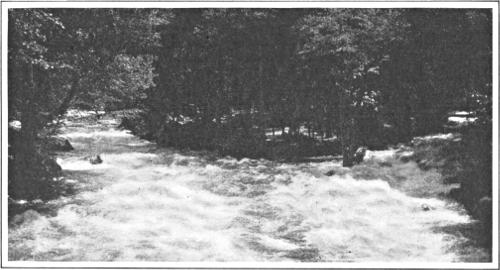
Photograph by A. C. Pillsbury
THE LAUGHING WATERS OF HAPPY ISLES
In some scenery there is an element of awe—a grimness that makes us shudder. The charm of the Yosemite is that, with all its scenic splendor it is so serenely beautiful, so restful in character, and so endearing. There is no lack of majesty. Lofty summits surround us—some of them stern in aspect. El Capitan is a vast, beetling cliff, the Three Brothers are grim granite companions, and the peak of Cloud’s Rest is remote and austere. But, down in the valley, all is gentle and lovely.
I have visited the valley more than once, and I know its spell. Its soothing influence dulls the edge of decision. However energetic and purposeful we may be on arrival, we find, after a few days, that we have, quite unconsciously, eaten of the lotus of forgetfulness. Plans for various strenuous activities are modified; things that at first seemed urgent are postponed; and the day of departure drops into the list of life’s little uncertainties. Events take their own course; we yield to the current. Yesterday we followed the mountain trail, and we were full of the stir and thrill of it. Today we find other and quieter joys. So we let the climbers now call us indolent. We let them take to the summits while we hold to the valley. We are content. The flowers that offer themselves at our feet are as fair as those that they find on the heights. The air about us is soft and fragrant, and “sweet is the whisper of the pine trees by the river.” Our hearts are in unison with the pastoral poet, and we ask for nothing better today than to rest here and dream in the Happy Isles.
The valley is undergoing changes and improvements. The conditions there have always been very simple. Within recent years the government, realizing that the Yosemite was a wonderful natural playground, has done much to develop it. If a visitor of former years should go to the Yosemite today, he would rub his eyes and exclaim at the changes. He would find the old Sentinel Hotel and cottages superseded by the luxurious new hotel, and the village largely transplanted to the other side of the Merced. In place of the old-fashioned stages, he would find the ever-present auto-car. He would find the Glacier Point Hotel renewed and enlarged, and many improvements in the valley camps. He would find well-equipped lodges and chalets scattered through the Park for the comfort of those who take the long, arduous trails. The Yosemite is now an all-year-round resort, where winter as well as summer sport may be enjoyed. Uncle Sam’s invitation is: “Come to your pleasure Park, forget your cares for a while, and rest and play.”

W. D. Moffat
Editor
The Mentor Association
ESTABLISHED FOR THE DEVELOPMENT OF A POPULAR INTEREST IN ART, LITERATURE, SCIENCE, HISTORY, NATURE, AND TRAVEL
CONTRIBUTORS—PROF. JOHN C. VAN DYKE, HAMILTON W. MABIE, PROF. ALBERT BUSHNELL HART, REAR ADMIRAL ROBERT E. PEARY, WILLIAM T. HORNADAY, DWIGHT L. ELMENDORF, HENRY T. FINCK, WILLIAM WINTER, ESTHER SINGLETON, PROF. G. W. BOTSFORD, IDA M. TARBELL, GUSTAV KOBBÉ, DEAN C. WORCESTER, JOHN K. MUMFORD, W. J. HOLLAND, LORADO TAFT, KENYON COX, E. H. FORBUSH, H. E. KREHBIEL, SAMUEL ISHAM, BURGES JOHNSON, STEPHEN BONSAL, JAMES HUNEKER, W. J. HENDERSON, AND OTHERS.
The purpose of The Mentor Association is to give its members, in an interesting and attractive way, the information in various fields of knowledge which everybody wants to have. The information is imparted by interesting reading matter, prepared under the direction of leading authorities, and by beautiful pictures, produced by the most highly perfected modern processes.
THE MENTOR IS PUBLISHED TWICE A MONTH
BY THE MENTOR ASSOCIATION, INC., AT 52 EAST NINETEENTH STREET, NEW YORK, N. Y. SUBSCRIPTION, THREE DOLLARS A YEAR. FOREIGN POSTAGE 75 CENTS EXTRA. CANADIAN POSTAGE 50 CENTS EXTRA. SINGLE COPIES FIFTEEN CENTS. PRESIDENT, THOMAS H. BECK; VICE-PRESIDENT, WALTER P. TEN EYCK; SECRETARY, W. D. MOFFAT; TREASURER, ROBERT M. DONALDSON; ASST. TREASURER AND ASST. SECRETARY, J. S. CAMPBELL
COMPLETE YOUR MENTOR LIBRARY
Subscriptions always begin with the current issue. The following numbers of The Mentor Course, already issued, will be sent postpaid at the rate of fifteen cents each.
NUMBERS TO FOLLOW
October 16. JOHN PAUL JONES. By Professor Albert Bushnell Hart, Harvard University.
November 1. RUSSIAN MUSIC. By Henry T. Finck, Author and Music Critic.
THE MENTOR ASSOCIATION, INC.
52 EAST 19th STREET, NEW YORK, N. Y.
THE MENTOR
WE OFFER YOU
The Mentor Index FREE
The MENTOR LIBRARY is itself a wonderful time saver. The Index, however, has now made it doubly valuable. Suppose, for instance, you have a letter to write, a speech to make; some member of your household has a paper for a woman’s club; one of the children has a topic assigned at school; where can material be found at a moment’s notice? Nowhere that we know of so readily, so concisely, so interestingly, as in this Index to The Mentor Library.
Take the subject General Aguinaldo—who is often referred to in the papers these days. See what The Mentor says of him. In the Index you read:
Aguinaldo, Gen., No. 89, M. 1
You turn to Mentor 89, monograph one. There you find the life story of Aguinaldo, right down to the present.
Remarkable, isn’t it? So it is on every one of the other thousands of subjects. You have at your finger tips what ordinarily would take you hours and even days to cover in scattered volumes. We offer one FREE, if you complete your Mentor Library now.
COST OF SETS OF PREVIOUS ISSUES
| Issues Nos. 1 to 110 inclusive | $16.50 |
| Issues Nos. 1 to 100 inclusive | 15.00 |
| Issues Nos. 1 to 90 inclusive | 13.50 |
| Issues Nos. 1 to 80 inclusive | 12.00 |
| Issues Nos. 1 to 70 inclusive | 10.50 |
| Issues Nos. 1 to 60 inclusive | 9.00 |
| Issues Nos. 1 to 50 inclusive | 7.50 |
| Issues Nos. 1 to 40 inclusive | 6.00 |
| Issues Nos. 1 to 30 inclusive | 4.50 |
| Issues Nos. 1 to 20 inclusive | 3.00 |
| Issues Nos. 1 to 10 inclusive | 1.50 |
FIFTEEN CENTS EXTRA FOR ODD COPIES
Payable $1.00 on Receipt of Bill and $2.00 Monthly
SEND NO MONEY NOW! Merely tell us at once how many copies you need to complete your set.
THE MENTOR ASSOCIATION
52 EAST NINETEENTH STREET—NEW YORK, N. Y.
MAKE THE SPARE
MOMENT COUNT

End of the Project Gutenberg EBook of The Mentor: The Yosemite Valley, Vol
4, Num. 16, Serial No. 116, October , by Dwight L. Elmendorf
*** END OF THIS PROJECT GUTENBERG EBOOK THE MENTOR: THE YOSEMITE ***
***** This file should be named 52131-h.htm or 52131-h.zip *****
This and all associated files of various formats will be found in:
http://www.gutenberg.org/5/2/1/3/52131/
Produced by Juliet Sutherland and the Online Distributed
Proofreading Team at http://www.pgdp.net
Updated editions will replace the previous one--the old editions will
be renamed.
Creating the works from print editions not protected by U.S. copyright
law means that no one owns a United States copyright in these works,
so the Foundation (and you!) can copy and distribute it in the United
States without permission and without paying copyright
royalties. Special rules, set forth in the General Terms of Use part
of this license, apply to copying and distributing Project
Gutenberg-tm electronic works to protect the PROJECT GUTENBERG-tm
concept and trademark. Project Gutenberg is a registered trademark,
and may not be used if you charge for the eBooks, unless you receive
specific permission. If you do not charge anything for copies of this
eBook, complying with the rules is very easy. You may use this eBook
for nearly any purpose such as creation of derivative works, reports,
performances and research. They may be modified and printed and given
away--you may do practically ANYTHING in the United States with eBooks
not protected by U.S. copyright law. Redistribution is subject to the
trademark license, especially commercial redistribution.
START: FULL LICENSE
THE FULL PROJECT GUTENBERG LICENSE
PLEASE READ THIS BEFORE YOU DISTRIBUTE OR USE THIS WORK
To protect the Project Gutenberg-tm mission of promoting the free
distribution of electronic works, by using or distributing this work
(or any other work associated in any way with the phrase "Project
Gutenberg"), you agree to comply with all the terms of the Full
Project Gutenberg-tm License available with this file or online at
www.gutenberg.org/license.
Section 1. General Terms of Use and Redistributing Project
Gutenberg-tm electronic works
1.A. By reading or using any part of this Project Gutenberg-tm
electronic work, you indicate that you have read, understand, agree to
and accept all the terms of this license and intellectual property
(trademark/copyright) agreement. If you do not agree to abide by all
the terms of this agreement, you must cease using and return or
destroy all copies of Project Gutenberg-tm electronic works in your
possession. If you paid a fee for obtaining a copy of or access to a
Project Gutenberg-tm electronic work and you do not agree to be bound
by the terms of this agreement, you may obtain a refund from the
person or entity to whom you paid the fee as set forth in paragraph
1.E.8.
1.B. "Project Gutenberg" is a registered trademark. It may only be
used on or associated in any way with an electronic work by people who
agree to be bound by the terms of this agreement. There are a few
things that you can do with most Project Gutenberg-tm electronic works
even without complying with the full terms of this agreement. See
paragraph 1.C below. There are a lot of things you can do with Project
Gutenberg-tm electronic works if you follow the terms of this
agreement and help preserve free future access to Project Gutenberg-tm
electronic works. See paragraph 1.E below.
1.C. The Project Gutenberg Literary Archive Foundation ("the
Foundation" or PGLAF), owns a compilation copyright in the collection
of Project Gutenberg-tm electronic works. Nearly all the individual
works in the collection are in the public domain in the United
States. If an individual work is unprotected by copyright law in the
United States and you are located in the United States, we do not
claim a right to prevent you from copying, distributing, performing,
displaying or creating derivative works based on the work as long as
all references to Project Gutenberg are removed. Of course, we hope
that you will support the Project Gutenberg-tm mission of promoting
free access to electronic works by freely sharing Project Gutenberg-tm
works in compliance with the terms of this agreement for keeping the
Project Gutenberg-tm name associated with the work. You can easily
comply with the terms of this agreement by keeping this work in the
same format with its attached full Project Gutenberg-tm License when
you share it without charge with others.
1.D. The copyright laws of the place where you are located also govern
what you can do with this work. Copyright laws in most countries are
in a constant state of change. If you are outside the United States,
check the laws of your country in addition to the terms of this
agreement before downloading, copying, displaying, performing,
distributing or creating derivative works based on this work or any
other Project Gutenberg-tm work. The Foundation makes no
representations concerning the copyright status of any work in any
country outside the United States.
1.E. Unless you have removed all references to Project Gutenberg:
1.E.1. The following sentence, with active links to, or other
immediate access to, the full Project Gutenberg-tm License must appear
prominently whenever any copy of a Project Gutenberg-tm work (any work
on which the phrase "Project Gutenberg" appears, or with which the
phrase "Project Gutenberg" is associated) is accessed, displayed,
performed, viewed, copied or distributed:
This eBook is for the use of anyone anywhere in the United States and
most other parts of the world at no cost and with almost no
restrictions whatsoever. You may copy it, give it away or re-use it
under the terms of the Project Gutenberg License included with this
eBook or online at www.gutenberg.org. If you are not located in the
United States, you'll have to check the laws of the country where you
are located before using this ebook.
1.E.2. If an individual Project Gutenberg-tm electronic work is
derived from texts not protected by U.S. copyright law (does not
contain a notice indicating that it is posted with permission of the
copyright holder), the work can be copied and distributed to anyone in
the United States without paying any fees or charges. If you are
redistributing or providing access to a work with the phrase "Project
Gutenberg" associated with or appearing on the work, you must comply
either with the requirements of paragraphs 1.E.1 through 1.E.7 or
obtain permission for the use of the work and the Project Gutenberg-tm
trademark as set forth in paragraphs 1.E.8 or 1.E.9.
1.E.3. If an individual Project Gutenberg-tm electronic work is posted
with the permission of the copyright holder, your use and distribution
must comply with both paragraphs 1.E.1 through 1.E.7 and any
additional terms imposed by the copyright holder. Additional terms
will be linked to the Project Gutenberg-tm License for all works
posted with the permission of the copyright holder found at the
beginning of this work.
1.E.4. Do not unlink or detach or remove the full Project Gutenberg-tm
License terms from this work, or any files containing a part of this
work or any other work associated with Project Gutenberg-tm.
1.E.5. Do not copy, display, perform, distribute or redistribute this
electronic work, or any part of this electronic work, without
prominently displaying the sentence set forth in paragraph 1.E.1 with
active links or immediate access to the full terms of the Project
Gutenberg-tm License.
1.E.6. You may convert to and distribute this work in any binary,
compressed, marked up, nonproprietary or proprietary form, including
any word processing or hypertext form. However, if you provide access
to or distribute copies of a Project Gutenberg-tm work in a format
other than "Plain Vanilla ASCII" or other format used in the official
version posted on the official Project Gutenberg-tm web site
(www.gutenberg.org), you must, at no additional cost, fee or expense
to the user, provide a copy, a means of exporting a copy, or a means
of obtaining a copy upon request, of the work in its original "Plain
Vanilla ASCII" or other form. Any alternate format must include the
full Project Gutenberg-tm License as specified in paragraph 1.E.1.
1.E.7. Do not charge a fee for access to, viewing, displaying,
performing, copying or distributing any Project Gutenberg-tm works
unless you comply with paragraph 1.E.8 or 1.E.9.
1.E.8. You may charge a reasonable fee for copies of or providing
access to or distributing Project Gutenberg-tm electronic works
provided that
* You pay a royalty fee of 20% of the gross profits you derive from
the use of Project Gutenberg-tm works calculated using the method
you already use to calculate your applicable taxes. The fee is owed
to the owner of the Project Gutenberg-tm trademark, but he has
agreed to donate royalties under this paragraph to the Project
Gutenberg Literary Archive Foundation. Royalty payments must be paid
within 60 days following each date on which you prepare (or are
legally required to prepare) your periodic tax returns. Royalty
payments should be clearly marked as such and sent to the Project
Gutenberg Literary Archive Foundation at the address specified in
Section 4, "Information about donations to the Project Gutenberg
Literary Archive Foundation."
* You provide a full refund of any money paid by a user who notifies
you in writing (or by e-mail) within 30 days of receipt that s/he
does not agree to the terms of the full Project Gutenberg-tm
License. You must require such a user to return or destroy all
copies of the works possessed in a physical medium and discontinue
all use of and all access to other copies of Project Gutenberg-tm
works.
* You provide, in accordance with paragraph 1.F.3, a full refund of
any money paid for a work or a replacement copy, if a defect in the
electronic work is discovered and reported to you within 90 days of
receipt of the work.
* You comply with all other terms of this agreement for free
distribution of Project Gutenberg-tm works.
1.E.9. If you wish to charge a fee or distribute a Project
Gutenberg-tm electronic work or group of works on different terms than
are set forth in this agreement, you must obtain permission in writing
from both the Project Gutenberg Literary Archive Foundation and The
Project Gutenberg Trademark LLC, the owner of the Project Gutenberg-tm
trademark. Contact the Foundation as set forth in Section 3 below.
1.F.
1.F.1. Project Gutenberg volunteers and employees expend considerable
effort to identify, do copyright research on, transcribe and proofread
works not protected by U.S. copyright law in creating the Project
Gutenberg-tm collection. Despite these efforts, Project Gutenberg-tm
electronic works, and the medium on which they may be stored, may
contain "Defects," such as, but not limited to, incomplete, inaccurate
or corrupt data, transcription errors, a copyright or other
intellectual property infringement, a defective or damaged disk or
other medium, a computer virus, or computer codes that damage or
cannot be read by your equipment.
1.F.2. LIMITED WARRANTY, DISCLAIMER OF DAMAGES - Except for the "Right
of Replacement or Refund" described in paragraph 1.F.3, the Project
Gutenberg Literary Archive Foundation, the owner of the Project
Gutenberg-tm trademark, and any other party distributing a Project
Gutenberg-tm electronic work under this agreement, disclaim all
liability to you for damages, costs and expenses, including legal
fees. YOU AGREE THAT YOU HAVE NO REMEDIES FOR NEGLIGENCE, STRICT
LIABILITY, BREACH OF WARRANTY OR BREACH OF CONTRACT EXCEPT THOSE
PROVIDED IN PARAGRAPH 1.F.3. YOU AGREE THAT THE FOUNDATION, THE
TRADEMARK OWNER, AND ANY DISTRIBUTOR UNDER THIS AGREEMENT WILL NOT BE
LIABLE TO YOU FOR ACTUAL, DIRECT, INDIRECT, CONSEQUENTIAL, PUNITIVE OR
INCIDENTAL DAMAGES EVEN IF YOU GIVE NOTICE OF THE POSSIBILITY OF SUCH
DAMAGE.
1.F.3. LIMITED RIGHT OF REPLACEMENT OR REFUND - If you discover a
defect in this electronic work within 90 days of receiving it, you can
receive a refund of the money (if any) you paid for it by sending a
written explanation to the person you received the work from. If you
received the work on a physical medium, you must return the medium
with your written explanation. The person or entity that provided you
with the defective work may elect to provide a replacement copy in
lieu of a refund. If you received the work electronically, the person
or entity providing it to you may choose to give you a second
opportunity to receive the work electronically in lieu of a refund. If
the second copy is also defective, you may demand a refund in writing
without further opportunities to fix the problem.
1.F.4. Except for the limited right of replacement or refund set forth
in paragraph 1.F.3, this work is provided to you 'AS-IS', WITH NO
OTHER WARRANTIES OF ANY KIND, EXPRESS OR IMPLIED, INCLUDING BUT NOT
LIMITED TO WARRANTIES OF MERCHANTABILITY OR FITNESS FOR ANY PURPOSE.
1.F.5. Some states do not allow disclaimers of certain implied
warranties or the exclusion or limitation of certain types of
damages. If any disclaimer or limitation set forth in this agreement
violates the law of the state applicable to this agreement, the
agreement shall be interpreted to make the maximum disclaimer or
limitation permitted by the applicable state law. The invalidity or
unenforceability of any provision of this agreement shall not void the
remaining provisions.
1.F.6. INDEMNITY - You agree to indemnify and hold the Foundation, the
trademark owner, any agent or employee of the Foundation, anyone
providing copies of Project Gutenberg-tm electronic works in
accordance with this agreement, and any volunteers associated with the
production, promotion and distribution of Project Gutenberg-tm
electronic works, harmless from all liability, costs and expenses,
including legal fees, that arise directly or indirectly from any of
the following which you do or cause to occur: (a) distribution of this
or any Project Gutenberg-tm work, (b) alteration, modification, or
additions or deletions to any Project Gutenberg-tm work, and (c) any
Defect you cause.
Section 2. Information about the Mission of Project Gutenberg-tm
Project Gutenberg-tm is synonymous with the free distribution of
electronic works in formats readable by the widest variety of
computers including obsolete, old, middle-aged and new computers. It
exists because of the efforts of hundreds of volunteers and donations
from people in all walks of life.
Volunteers and financial support to provide volunteers with the
assistance they need are critical to reaching Project Gutenberg-tm's
goals and ensuring that the Project Gutenberg-tm collection will
remain freely available for generations to come. In 2001, the Project
Gutenberg Literary Archive Foundation was created to provide a secure
and permanent future for Project Gutenberg-tm and future
generations. To learn more about the Project Gutenberg Literary
Archive Foundation and how your efforts and donations can help, see
Sections 3 and 4 and the Foundation information page at
www.gutenberg.org Section 3. Information about the Project Gutenberg
Literary Archive Foundation
The Project Gutenberg Literary Archive Foundation is a non profit
501(c)(3) educational corporation organized under the laws of the
state of Mississippi and granted tax exempt status by the Internal
Revenue Service. The Foundation's EIN or federal tax identification
number is 64-6221541. Contributions to the Project Gutenberg Literary
Archive Foundation are tax deductible to the full extent permitted by
U.S. federal laws and your state's laws.
The Foundation's principal office is in Fairbanks, Alaska, with the
mailing address: PO Box 750175, Fairbanks, AK 99775, but its
volunteers and employees are scattered throughout numerous
locations. Its business office is located at 809 North 1500 West, Salt
Lake City, UT 84116, (801) 596-1887. Email contact links and up to
date contact information can be found at the Foundation's web site and
official page at www.gutenberg.org/contact
For additional contact information:
Dr. Gregory B. Newby
Chief Executive and Director
gbnewby@pglaf.org
Section 4. Information about Donations to the Project Gutenberg
Literary Archive Foundation
Project Gutenberg-tm depends upon and cannot survive without wide
spread public support and donations to carry out its mission of
increasing the number of public domain and licensed works that can be
freely distributed in machine readable form accessible by the widest
array of equipment including outdated equipment. Many small donations
($1 to $5,000) are particularly important to maintaining tax exempt
status with the IRS.
The Foundation is committed to complying with the laws regulating
charities and charitable donations in all 50 states of the United
States. Compliance requirements are not uniform and it takes a
considerable effort, much paperwork and many fees to meet and keep up
with these requirements. We do not solicit donations in locations
where we have not received written confirmation of compliance. To SEND
DONATIONS or determine the status of compliance for any particular
state visit www.gutenberg.org/donate
While we cannot and do not solicit contributions from states where we
have not met the solicitation requirements, we know of no prohibition
against accepting unsolicited donations from donors in such states who
approach us with offers to donate.
International donations are gratefully accepted, but we cannot make
any statements concerning tax treatment of donations received from
outside the United States. U.S. laws alone swamp our small staff.
Please check the Project Gutenberg Web pages for current donation
methods and addresses. Donations are accepted in a number of other
ways including checks, online payments and credit card donations. To
donate, please visit: www.gutenberg.org/donate
Section 5. General Information About Project Gutenberg-tm electronic works.
Professor Michael S. Hart was the originator of the Project
Gutenberg-tm concept of a library of electronic works that could be
freely shared with anyone. For forty years, he produced and
distributed Project Gutenberg-tm eBooks with only a loose network of
volunteer support.
Project Gutenberg-tm eBooks are often created from several printed
editions, all of which are confirmed as not protected by copyright in
the U.S. unless a copyright notice is included. Thus, we do not
necessarily keep eBooks in compliance with any particular paper
edition.
Most people start at our Web site which has the main PG search
facility: www.gutenberg.org
This Web site includes information about Project Gutenberg-tm,
including how to make donations to the Project Gutenberg Literary
Archive Foundation, how to help produce our new eBooks, and how to
subscribe to our email newsletter to hear about new eBooks.